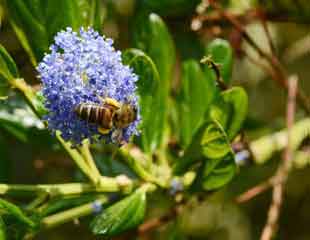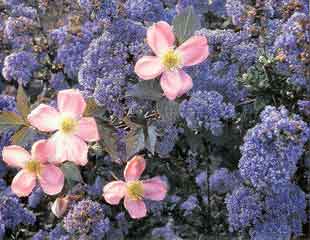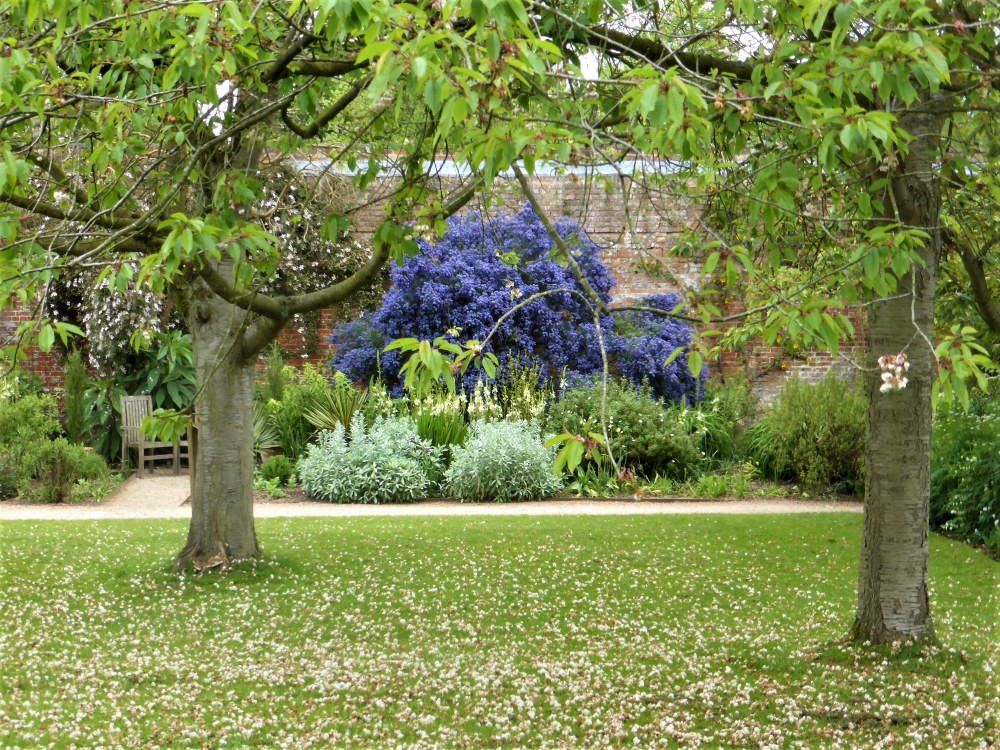


How to grow Ceanothus
Key Points:
Height: from 1m to 3m+
Light: Full sun in a sheltered position
soil: Well-drained, Ceanothus do not thrive on waterlogged or chalky soils
Special Features: Evergreen shrub/small tree with lovely blue flowers, much loved by bees. Hardy, but best planted away from cold winds

I tagged ceanothus “Green Wheelbarrow because when planted in a sheltered spot, it is easy to grow and trouble-free. Ideal in many areas, especially around the south of England and in more sheltered gardens. It can be more difficult to grow in colder areas, especially in gardens in the North of England. However, it can thrive with care taken to plant in a sheltered corner of the garden.
Where to plant Ceanothus and Hardiness ratings
Ceanothus is a fast-growing, evergreen shrub with stunning blue flowers in late spring and early summer, with some varieties flowering in autumn. Ceanothus looks fantastic when in full bloom — a beautiful blue cloud.
The most important point when growing Ceanothus is to plant it in the right place at the start, which is a sheltered spot in full sun, away from chilly winds. Ceanothus originates from North America, particularly California, hence its common name, the California Lilac. Its origins account for its dislike of cold, exposed gardens. Ceanothus is H4 hardy ( More information about frost hardy) defined as hardy in most of the UK from -10 to -5.
Ceanothus planted in a cold or exposed position—particularly where it faces harsh winds—can be prone to wind burn, causing the foliage to brown. Once settled, Ceanothus is generally trouble-free and makes an excellent, bee-friendly addition to the garden.
In exposed gardens, consider growing the hardiest of varieties, C 'Autumnal Blue', which, as the name suggests, flowers in the late summer and early autumn, illustrated below, or one of the deciduous types.
Ceanothus are short lived shrubs
Ceanothus grows fast and furiously, and runs out of growing steam after about 10-15 years. The better the growing conditions, the longer the shrub will live. In wetter conditions, the shrub is shorter-lived, and overall between 5-15 years. The shrub may continue to grow, but look scruffy and leggy. Evergreen Ceanothus do not respond well to hard pruning. At this stage, it is best to start again with a new shrub. It is worth bearing in mind when choosing a spot to plant Ceanothus that it may not be there forever.
The image shows the exception to prove the rule. The Ceanothus in the image has reached good maturity, but it's fair to say it is benefiting from the warmth of growing against a wall, in a sheltered walled garden, so the ideal conditions to extend its life span.
Two images of Ceanothus from a distance and the same shrub in close up
showing the dozens of soft blue flowers
How to Prune Ceanothus
Routinely pruning Ceanothus is not necessary. You can prune Ceanothus if it outgrows its allotted space, but avoid hard pruning. The evergreen varieties (most) are pruning group 8, which recommends pruning after flowering. Most Ceanothus flower in late May and June, and you are safe to prune from late June onwards. At all times, avoid cutting back into the old wood or cutting back hard, as the shrub may not recover.
There are some less common deciduous varieties, illustrated below left, which are pruning group 6 to be pruned in early spring.
It is always good to mulch and feed after pruning. If there is a bad winter, and the plant suffers from wind burn, it may be necessary to prune out the damaged areas.
Good varieties of Ceanothus for your garden
Picking a Ceanothus for your garden depends on the size you would like and hardiness. Very few of the evergreen varieties are fully hardy, (what is hardy?) Listed as H4 is :
C. thyrisiflorus (Blue blossom) which is a low growing, spreading variety, evergreen, and with light blue flowers growing up to 1.5 metres but taller if grown against the shelter of a wall up to 2.5 meters.
C. x delilianus 'Henri Desfossé' is a hardy variety although it is deciduous with dark blue flowers from July to September. Most other evergreen varieties are less reliably hardy and may require some winter protection.
Some Ceanothus grow large, up to 6 metres tall, with a spread of 8 meters, such as Trewithen Blue, which makes checking the plant label important to know the eventual size of the shrub.
Good strong blue varieties with the RHS garden merit award are:
'Trewithen Blue' and 'Cascade C. ‘Autumnal Blue’ upright growing to around 3 meters with sky-blue flowers from mid- summer to early Autumn.
Ceanothus 'Puget Blue' medium sized 1.5 - 2.5m
Ceanothus 'Blue Mound' is more compact, growing up to around 1.5 meters in the right conditions.
C. ‘Concha' is around 3 meters with darker blue flowers in late spring.
C. 'Skylark' another medium sized variety
There are lots to choose from, around 55 varieties in all.
Confusingly, many are described as H4 which should be hardy to -10 but are also described as 'needing winter protection'. All I can offer is that in an exposed garden, which I have had, Ceanothus fail to thrive and the leaves suffered from wind burn. Despite the hardy description, I would only grow the evergreen varieties in a sheltered spot, preferably against a wall.
The early spring flowering varieties of Ceanothus look good with Clematis Montana illustrated in the image above right.
Ceanothus is also suitable and ideal for planting in coastal areas.
There are also a few deciduous varieties of Ceanothus, such as Ceanothus x Pallidus 'Perle Rose' illustrated below left, which have delicate, attractive pale pink flowers from mid-summer to early Autumn. This variety is also H4 hardy and it needs to be planted in a sheltered spot on light well-drained soil.
If Ceanothus is not what you are looking for, check out shrubs and bushes; spring flowering shrubs; summer flowering shrubs; shrubs with autumn and winter interest; and evergreen shrubs.
Crocus has a lovely range of Ceanothus for sale, including C. 'Skylark', Concha and Autumnal blue- images and prices click here (affiliate link)
Ceanothus x Pallidus 'Perle Rose'

This is an unusual form of Ceanothus, it is pink and deciduous.
Ceanothus 'Autumnal blue'

This variety of Ceanothus flowers in the Autumn .


